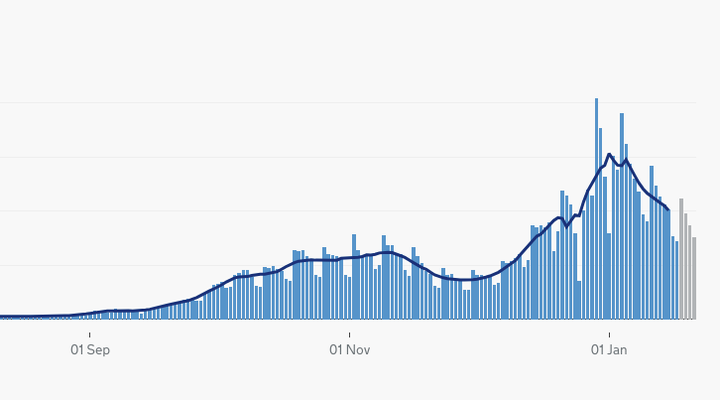The number of people testing positive for Covid-19 in the UK is decreasing, though figures remain higher than the first wave of the pandemic.
Confirmed cases reached an all-time high on December 29 with 81,522, spiking again on January 4 to 76,090, according to official government figures.
The most recent complete set of data available lists 39,179 cases on January 19. It’s a significant fall – around 50% down since the late December peak – and the indictors suggest the trend has continued in the subsequent days.
But it was December 14 when the last time the seven-day average was below 30,000 cases a day – suggesting that while the UK’s case rate is heading in the right direction, it remains stubbornly high.
And with the the daily Covid-19 death toll still regularly topping 1,000, how hopeful can people be that there is light at the end of the tunnel?
Professor Oliver Johnson, director of the institute of statistical science at the University of Bristol, told HuffPost UK it may take the cases trend a little more time to be reflected in deaths and hospitalisations.
He said: “Due to the lag effect, it’s probably the case that people dying today were infected sometime around New Year.
“I think it might be reasonable to think that if they haven’t already, deaths might peak around this week.”

Johnson lays the blame for the rise in figures at the door of the new variant of coronavirus, said to be more deadly and transmissible.
During the second lockdown, figures for infection rates began rising again towards the end of November.
Johnson said: “In retrospect, knowing what we know now, that was probably a sort of smoking gun that something strange was happening, because numbers shouldn’t have been going up during lockdown.
“There were a lot of people, and I was one of them, who were feeling: ‘Are we going to be able to get this thing under control at all?’ Whereas now, a few weeks into the year and cases have come down, to be honest it has been a pleasant surprise really.”
But cases aren’t the only indicator to take into consideration.
At a Downing Street press conference on Monday, health secretary Matt Hancock referred to 37,000 people in hospital with coronavirus – almost twice the peak in the first wave in April. More people were on ventilators than at any time in the pandemic, he added.
Documents released by the Scientific Advisory Group for Emergencies (Sage) on Friday said community prevalence of coronavirus will be higher than it was during the first national lockdown in the spring of 2020 – even if the R rate remains below 1 until mid-February.
Members say the prevalence will drop more slowly than seen during April and May last year.
At present, data shows that Covid-19 infections are falling somewhere around a quarter every fortnight, compared with halving in April. This is in part due to the new variant and slightly lesser restrictions in the current national lockdown compared to the first one.
Sage warned on Friday that coronavirus cases remain “dangerously high and we must remain vigilant to keep this virus under control.”
Nonetheless, Johnson is hopeful that the numbers will continue to drop and predicts the data will start to reflect the vaccination drive in a few weeks. To date, more than 6.5m people in the UK have received a first dose of the jab.
Coupled with the news on Monday that the Moderna vaccine is believed to be effective against new strains of the virus, including the UK variant, there just might be reasons to be cautiously optimistic.
The below NHS case figures are for the seven-day rolling average up to January 11 and January 24, and the decrease is a comparison with the seven-day rolling average to the previous day.
The number in brackets is the number of cases per 100,000 people.
January 11 change in cases by region by cases per 100,000 people (NHS Digital)
- East of England -9% (704.7)
- South-east -7% (645.9)
- London -6% (958.4)
- North-east -2% (390.6)
- East Midlands 14% (445.1)
- South-west 14% (368.3)
- Yorkshire and The Humber 14% (323.0)
- West Midlands 23% (588.9)
- North-west 46% (612.1)
January 24 change in cases
- London -31% (505.2)
- South-East -28% (373.7)
- South-West -27% (254.0)
- East -26% (401.1)
- North West -24% (414.6)
- West Midlands -14% (489.5)
- East Midlands -10% (367.3)
- Yorkshire and The Humber -8% (243.4)
- North East -7% (309.1)
And Boris Johnson has seized on the more positive signs. On Monday, he said he wants England’s schools to reopen “as fast as possible” and the government would be “looking at the potential of relaxing some measures” when lockdown restrictions are reviewed on February 15.
But at a Downing Street press conference on Monday, Hancock and England’s deputy chief medical officer Jenny Harries struck a more cautious tone – highlighting the strain coronavirus cases were putting on the NHS.
Hancock said that the “facts on the ground” showed the “pressure on the NHS remains huge”. He said he understood the “yearning” to get out of the lockdown but added: “I think most people understand why it is difficult to put a timeline on it.”
While there are “better days that lie ahead”, Hancock said, “we have to hold our nerve and persevere through this difficult winter”, adding: “This is not a moment to ease up.”
Dr Harries warned: “We are not out of this by a very long way.”
The current coronavirus rates were still causing concern, patience was needed about the vaccination programme and the NHS still faced the usual winter pressures, she said.
